Magnification equation Study guides, Class notes & Summaries
Looking for the best study guides, study notes and summaries about Magnification equation? On this page you'll find 184 study documents about Magnification equation.
Page 2 out of 184 results
Sort by
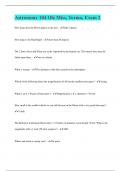
-
Astronomy 104 Ole Miss, Torma, Exam 2
- Exam (elaborations) • 8 pages • 2024
-
- $9.99
- + learn more
Astronomy 104 Ole Miss, Torma, Exam 2 How large does the Moon appear in the sky? - half a degree How large is the Big Dipper - more than 20 degrees The 2 Stars Alcor and Mizar are easily seperated by the human eye. This means they must be father apart than.. - one arc minute What is seeing? - The diameter of the blur caused by the atmosphere Which of the following limits the magnification of all but the smallest telescopes? - seeing What is an 8 x 50 pair of binoculars? - Magn...

-
MICROBIOLOGY: CHAPTER 3 THE METHODS FOR STUDYING MICROORGANISMS
- Exam (elaborations) • 4 pages • 2024
-
- $10.49
- + learn more
What are the 6 I's of culturing microbes? - Answer-Inoculation Incubation Isolation Inspection Information Gathering Identification What is the function of the condenser on a microscope? - Answer-Focuses the light waves through the iris What is the function of the oculars on a microscope? - Answer-To observe the specimen on the slide and enlarge it What is the function of the objective lens on a microscope? - Answer-To focus and enlarge the specimen What is the function of the ...
![NBEO- Physiological Optics (Mostly Conceptual) Questions and answers, rated A+[LATEST EXAM UPDATES]](/docpics/5367434/664af266879e7_5367434_121_171.jpeg)
-
NBEO- Physiological Optics (Mostly Conceptual) Questions and answers, rated A+[LATEST EXAM UPDATES]
- Exam (elaborations) • 68 pages • 2024
- Available in package deal
-
- $11.49
- + learn more
NBEO- Physiological Optics (Mostly Conceptual) Questions and answers, rated A+ Which of the following is NOT true when comparing BIO to Direct Ophthalmoscopy? A) BIO provides a larger field of view than Direct Ophthalmoscopy B) Direct Ophthalmoscopy has a larger depth of focus than BIO C) Direct Ophthalmoscopy has more magnification than BIO D) BIO provides a real, inverted image E) Direct Ophthalmoscopy provides a virtual, upright image - -B (BIO has larger depth of focus) Does BIO o...

-
AQA GCSE PHYSICS EXAM QUESTIONS AND ANSWERS 2023.
- Exam (elaborations) • 10 pages • 2023
- Available in package deal
-
- $13.99
- + learn more
Transverse waves The vibrations are at right angles to the direction of travel. Longitudinal waves The vibrations are along the same direction as the direction of travel. Examples of transverse waves Light and other types of electromagnetic radiation, as well as water waves and S waves (a type of seismic wave). Examples of longitudinal waves Sound waves and waves in a stretched spring, and P waves. Equation linking time, period and frequency Period = 1/frequency Equ...

-
AQA A-Level Biology. 3.2 – Cells questions and answers 100% guaranteed success.
- Exam (elaborations) • 24 pages • 2024
-
- $14.99
- + learn more
AQA A-Level Biology. 3.2 – Cells questions and answers 100% guaranteed success. Structure of Nucleus. - correct answer. 1. Nuclear envelope: double membrane surrounding nucleus, outer membrane continuous with the (R)ER of the cell. 2. Nuclear pores: allow the passage of larger molecules, such as mRNA, out of the nucleus. 3. Nucleoplasm: granular, jelly-like material making up the bulk of the nucleus. 4. Chromosomes: protein-bound, linear DNA. 5. Nucleolus: small...
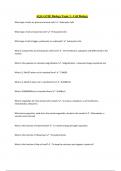
-
AQA GCSE Biology Topic 1 - Cell Biology
- Exam (elaborations) • 8 pages • 2024
- Available in package deal
-
- $10.99
- + learn more
AQA GCSE Biology Topic 1 - Cell Biology What type of cells are plant and animal cells? ️Eukaryotic Cells What type of cell are bacterial cells? ️Prokaryotic Cells What type of cell is bigger, prokaryotic or eukaryotic? ️Eukaryotic cells What 3 components do all eukaryotic cells have? ️Cell membrane, cytoplasm and DNA stored in the nucleus What is the equation to calculate magnification? ️Magnification = observed image size/actual size What is 2.34x105 when not in standar...
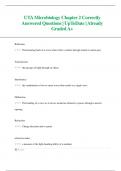
-
UTA Microbiology Chapter 2 Correctly Answered Questions| UpToDate | Already Graded A+
- Exam (elaborations) • 6 pages • 2024
- Available in package deal
-
- $10.39
- + learn more
Reflection : The bouncing back of a wave when it hits a surface through which it cannot pass. Transmission : the passage of light through an object Interference : the combination of two or more waves that results in a single wave Diffraction : The bending of a wave as it moves around an obstacle or passes through a narrow opening Refraction : Change direction and or speed refractive index : a measure of the light-bending ability of a medium 2 | P a g e Refractive index equation :...
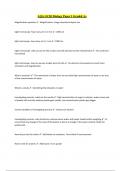
-
AQA GCSE Biology Paper 1 Graded A+
- Exam (elaborations) • 12 pages • 2024
- Available in package deal
-
- $9.99
- + learn more
AQA GCSE Biology Paper 1 Graded A+ Magnification equation ️Magnification= image size/actual object size Light microscope- how many um in 1 mm ️1000 um light microscope- how many nm in 1 um ️1000 nm Light microscope- why can we see the nucleus and cell wall but not the mitochondria ️Too small and not stained light microscope- how can we see smaller parts of cells ️An electron microscope has much more resolution and magnification What is osmosis? ️The movement of water ...
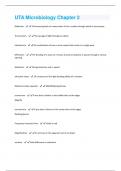
-
UTA Microbiology Chapter 2 Graded A Q&A Complete
- Exam (elaborations) • 4 pages • 2024
- Available in package deal
-
- $7.99
- + learn more
Reflection - The bouncing back of a wave when it hits a surface through which it cannot pass. Transmission - the passage of light through an object Interference - the combination of two or more waves that results in a single wave Diffraction - The bending of a wave as it moves around an obstacle or passes through a narrow opening Refraction - Change direction and or speed refractive index - a measure of the light-bending ability of a medium Refractive index equation - 300,000kps/speed kps...

-
AQA GCSE Biology Exam with Guaranteed Accurate Answers
- Exam (elaborations) • 33 pages • 2024
-
- $14.99
- + learn more
What does a nucleus do? - correct answer It contains genetic material and controls the activities of the cell What does cytoplasm do? - correct answer It's a gel-like substance where most of the chemical reactions happen. It contains enzymes that control these chemical reactions What does a cell membrane do? - correct answer It holds the cell together and controls what goes in and out What do mitochondria do? - correct answer These are where most of the reactions for aerobic respiratio...

$6.50 for your textbook summary multiplied by 100 fellow students... Do the math: that's a lot of money! Don't be a thief of your own wallet and start uploading yours now. Discover all about earning on Stuvia


